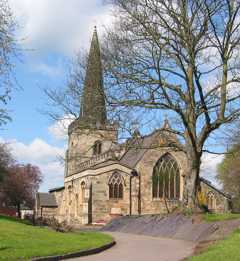For this church:    |
 StaplefordSt HelenNottingham Archdeaconry Nottingham South Deanery IntroductionStapleford started as a cluster of dwellings at the point where the old Portway came down from the hill tops in order to cross the flood plain of the Erewash. The Gospel has been preached here for well over 1000 years. At the time of the Domesday Survey in 1086 Stapleford was reported to have had a church and a priest. In addition to the Domesday record we also have the Saxon cross. The latest thinking dates this from about 920 AD and it would probably have been erected in the churchyard. The Saxon church, of which nothing now remains, would probably have been of wood and thatch. In the 13th century the present church was built on a terrace just above the flood plain and over the years it has been added to and altered until we get the building that we have today. The intervening years have not been kind to Stapleford. The dissolution of the monasteries left it bereft of support. Its tithes were sold off to the highest bidder and, if there was an understanding that the purchaser should also support the priest and the church, this does not seem to have materialised. The village was always poor. It lacked a wealthy patron and it has been a constant struggle to maintain the church. The village was quite small. In 1603 there were 150 communicants – no more that 50 families. In 1764 there were 120 families. It was not until Victorian times that the village began to expand with the coming of the lace trade and in 1841 at the time of the first census the population was 1837. However, by 1901 it had climbed to 6180. The church was built of a soft sandstone that did not withstand the weather and needed constant repair. The windows eroded and the medieval glass was lost. The walls were patched up with anything that was around and, to cap it all, the building seems to have been built on a fault line that runs through the churchyard. St Helen’s has had two mission churches: St Andrew’s, built in 1908 and sold in 2006, and St Luke’s which is still open. Particular thanks to Keith Goodman, Chris Bull and Meg Oliver for research on this entry |





